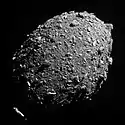2022 FD1
2022 FD1 is a small, metre-sized Apollo near-Earth asteroid that was eclipsed by Earth and made its closest approach 8,470 km (5,260 mi) from Earth's surface on 25 March 2022.[lower-alpha 1] It entered Earth's shadow at 8:10 UTC and became invisible until egress at 8:45 UTC.[5] Its brightness from Earth reached a peak apparent magnitude of 13 shortly before closest approach at 09:13 UTC.[6] By that time, the asteroid was moving at a speed of 18.5 km/s (11.5 mi/s) relative to Earth and was located in the far Southern hemisphere sky.[4][6]
| Discovery[1][2] | |
|---|---|
| Discovered by | K. Sárneczky |
| Discovery site | Piszkéstető Stn. |
| Discovery date | 24 March 2022 |
| Designations | |
| 2022 FD1 | |
| Sar2594[3] | |
| NEO · Apollo[4][1] | |
| Orbital characteristics[4] | |
| Epoch 21 January 2022 (JD 2459600.5) | |
| Uncertainty parameter 6 | |
| Observation arc | 8.4 hours[1] |
| Aphelion | 2.653 AU |
| Perihelion | 0.719 AU |
| 1.686 AU | |
| Eccentricity | 0.5735 |
| 2.19 yr (800 days) | |
| 309.949° | |
| 0° 27m 0.765s / day | |
| Inclination | 9.446° |
| 4.374° | |
| 256.448° | |
| Earth MOID | 0.000168 AU (25,100 km) |
| Jupiter MOID | 2.51 AU |
| Physical characteristics | |
Mean diameter | 2–4 m[3] |
| 31.02±0.28[4] | |
2022 FD1 was discovered on 24 March 2022, by astronomer Krisztián Sárneczky at Konkoly Observatory's Piszkéstető Station in Budapest, Hungary.[2] It was his next near-Earth asteroid discovery after the impactor 2022 EB5 from early March 2022.[3]

Sun · Earth · 2022 FD1
| Parameter | Epoch | Period (p) |
Aphelion (Q) |
Perihelion (q) |
Semi-major axis (a) |
Eccentricity (e) |
Inclination (i) |
|---|---|---|---|---|---|---|---|
| Units | (days) | AU | (°) | ||||
| Pre-flyby | 2021 March 13[4] | 928 | 2.863 | 0.790 | 1.863 | 0.567 | 9.440 |
| Post-flyby | 2022-Dec-17[1][6] | 795 | 2.610 | 0.751 | 1.681 | 0.553 | 4.490 |
Notes
- Earth has a radius of 6,371 km and 2022 FD1 nominally passed about 14,845+8
−7 km from the center of Earth. The asteroid's distance from Earth's surface at closest approach is the difference between the asteroid closest approach radius and Earth's radius. (14,845 – 6,371 = 8,474)
References
- "2022 FD1". Minor Planet Center. Retrieved 26 March 2022.
- "MPEC 2022-F48 : 2022 FD1". Minor Planet Electronic Circular. Minor Planet Center. 25 March 2022. Archived from the original on 26 March 2022. Retrieved 26 March 2022.
- Whitt, Kelly Kizer (25 March 2022). "Whoa! Another asteroid whizzes past Earth hours after discovery". EarthSky. Archived from the original on 26 March 2022. Retrieved 26 March 2022.
- "JPL Small-Body Database Browser: (2022 FD1)" (2022-03-25 last obs.). Jet Propulsion Laboratory. Archived from the original on 6 October 2021. Retrieved 26 March 2022.
- Gray, Bill J. (25 March 2022). "Re: Total NEO eclipse!". groups.io. Archived from the original on 26 March 2022. Retrieved 26 March 2022.
- "JPL Horizons On-Line Ephemeris for 2022 FD1 on 2022-Mar-25". JPL Horizons On-Line Ephemeris System. Jet Propulsion Laboratory. Archived from the original on 26 March 2022. Retrieved 26 March 2022. Ephemeris Type: Elements and Center: 500. Note that there is no magnitude drop during the Earth eclipse between 8:10–8:45 UT as JPL Horizons does not take Earth's shadow into account.
External links
- 2022 FD1 at NeoDyS-2, Near Earth Objects—Dynamic Site
- 2022 FD1 at ESA–space situational awareness
- 2022 FD1 at the JPL Small-Body Database

